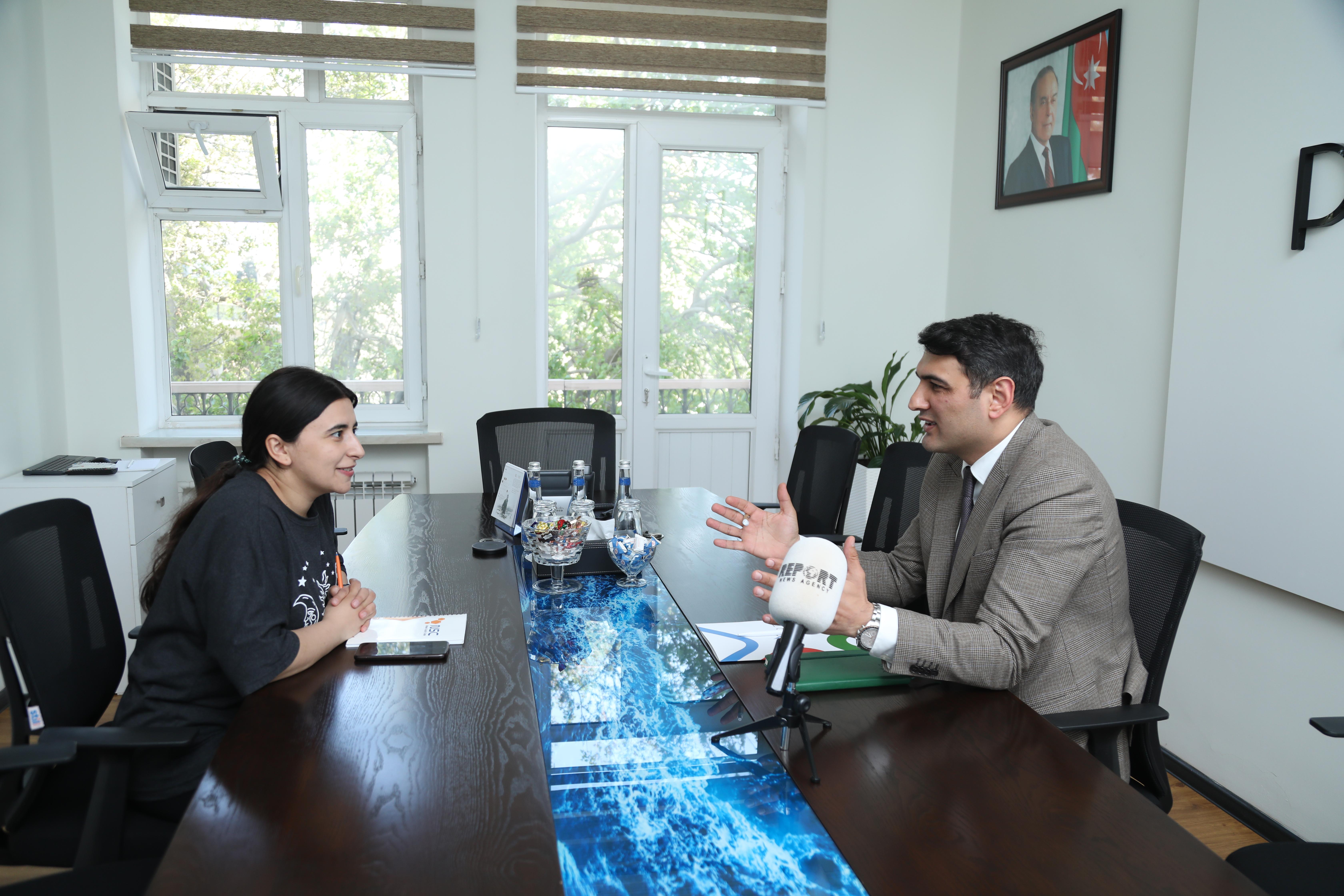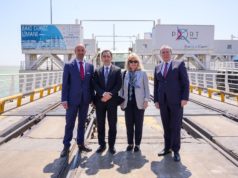Head of Strategic Planning and Development Department at Baku International Sea Trade Port CJSC, Khudayar Hasanli gave an interview to Report:
– Against the background of changing geopolitical situation in the world, what are the new challenges in the field of logistics in the region? How much is the volume of cargo attracted to the middle corridor expected to increase?
– In the East-West corridor, the northern part passing through Kazakhstan and Russia was the busiest transport corridor. The Middle Corridor (Trans-Caspian International Transport Route), which operates in the direction of Central Asia, Azerbaijan, and the Black Sea countries, is a newer transport and logistics line than the East-West Corridor. Despite the fact that the Middle Corridor is new, we have seen a significant increase in freight traffic in this corridor over the past 3-5 years. Cargo transportation in this direction was initially started in 2018.
Within the framework of pilot projects, the possibilities of this corridor were studied, and problems during cargo transportation in the corridor became known. Faster transition and optimal logistics solutions in accordance with the available opportunities were provided. Due to the new geopolitical situation, there are great opportunities to attract regional cargo flows and international cargo to and from China to the Middle Corridor. Drawing new international shipment to the Middle Corridor also creates excellent opportunities for Azerbaijan. In order to take advantage of these opportunities, some assessments and comparative analyzes are conducted. Of course, it won’t be easy in the short term to transfer all large cargo flows, which are transported through Russia and Kazakhstan, to the Middle Corridor. Because the Middle Corridor has traditional transportation, and sustainability has been ensured by forming optimal logistics solutions for this transportation.
Optimal and efficient logistics solutions for new types of cargo are now being and will be adapted to the corridor. Depending on the types of cargos, the Port of Baku, Azerbaijan Railways CJSC, Azerbaijan Caspian Shipping Company, and land transportation have certain potential, and there is a possibility for the growth of this potential.
– How much can the Port of Baku increase cargo handling?
– The total volume of cargo handling in the Port of Baku is 15 million tons. Potentials for various types of cargo, as well as for the form of shipment are different.
Wagons entering the port by rail through the ferry (train ferry) terminal are loaded directly onto the ferry. These processes are carried out on two ferry bridges with adjustable bridges equipped with direct railway lines. Along with passengers, trucks, passenger cars, and other vehicles can be loaded on ships at this terminal. The carrying capacity of the ferry terminal is 6.2 million tons per year.

Other intermodal transport units other than Ro-Ro terminal railway wagons are loaded on and unloaded from Ro-Ro (Ro-Pax) type vessels at this terminal. The Ro-Ro terminal has a cargo handling capacity of 1.8 million tons per year, which allows it to handle about 60,000 wheeled vehicles a year.
The cargo handling capacity of the main cargo terminal is 7 million tons per year. The terminal infrastructure includes 7 general cargo bridges, one of which has a solid foundation and is designed for loading and unloading heavy freight. 4 bridges are equipped with railways and 6 new portal cranes with different specifications. In this terminal, cargo in various unified containers (including those placed in containers) and shipments in the form of piles and styles can be unloaded and loaded from multiple means of transport (ship, wagon, truck).
During the construction of the Port of Baku, it was considered that the cargo would be handled by being diversified. In other words, the volume potential of all types of goods imported to our country, exported, and transited simultaneously for the medium term has been studied, and the terminals have been built accordingly. Now, when it comes to loads that meet our potential, their shipment is provided in the most efficient way. However, in the case of new types of cargo or larger volumes of the same kind, new equipment and techniques will have to be built for additional infrastructure and logistics solutions. These processes are monitored closely, and a new package of solutions and proposals for the short- and medium-term is being developed with the participation of relevant partners.
– Is it planned to further diversify the cargo coming to Azerbaijan?
– At present, there is a large amount of cargo from Kazakhstan. They used to be supplied to Europe and the Black Sea coast through Russia, and now there is a great potential to attract that cargo to the Middle Corridor. These cargoes include large wagon and ferry shipments, which can eventually arrive at the terminals of the Port of Baku. The potential of our ferry terminals is great.

Azerbaijan Caspian Shipping CJSC has enough ships. Currently, intensive work is underway to attract these cargoes. At the same time, there is a large volume of freight in the direction of container transportation, and we will attract this cargo to the best of our ability. For example, load going to Southern Europe, and Europe, is crucial for us. As a pilot project, cargo has already been shipped from the Middle Corridor to Europe via Azerbaijan, but the block trains have not been sustainable in this corridor. The block trains moved from China to the Black Sea coast, Turkiye, and Georgia. These cargoes are constantly transported. Now we need to expand the infrastructure, as well as alternative routes to the West, along the corridor for these goods to proceed to Europe.
The cargo is diversified after having arrived in Azerbaijan. The corridor, which includes Azerbaijan, is stable and reliable for cargo transportation. After Azerbaijan, freight is sent to Europe through Georgia via the Black Sea, and there is an opportunity to send cargo to Turkiye and Europe using the Baku-Tbilisi-Kars (BTK) railway. The infrastructure owners consider using these two routes (the Black Sea and BTK) as an alternative. By using two alternative routes, we will be able to work more efficiently, and there will be no cargo traffic jams. The cargo will be sent in two directions. A feeder operates as part of the Trans-Caspian International Transport Route across the Black Sea and heads for Poti-Constanta (Romanian port).
– What is being done to expand infrastructure opportunities?
– We continue discussions with Azerbaijan Railways CJSC and Azerbaijan Caspian Shipping CJSC. We debate the harmonization of our potentials and do real work to increase our existing potential by optimizing operations and increasing speed.
We have already calculated how much capacity we can increase in which direction, and at the same time, we are consulting on what infrastructure opportunities we can expand in the short- and medium-term. All infrastructure owners (Port of Baku, Azerbaijan Railway, Azerbaijan Caspian Shipping Company) have prepared reports and submitted them to the government. The report proposes solutions to develop our infrastructure capabilities in the short- and medium-term and outlines how we can grow the country’s infrastructure capabilities by making a short-term investment. The goal is to attract new loads to the maximum.

– What services does the Port of Baku want to optimize?
– At present, different fertilizers, mainly urea and sulfur, are loaded on the three various bridges of the Port of Baku. We are currently building a fertilizer terminal with a capacity of more than 2.5 million tons annually. These cargoes are presently being transported at our main cargo terminal.
The fertilizer terminal is expected to be ready for use by the end of this year or early next year. This will allow us to attract more fertilizer from Central Asia and take advantage of the new geopolitical situation by eliminating the overload on existing bridges.
Our main goal is to ensure that cargo owners use this corridor stably by offering the most efficient and cost-effective loading service. As we are already working with all partners in this direction, I think that operational solutions will be formed in the near future, and a large volume of cargo that previously passed through the North Corridor will remain in this corridor on a regular basis.
There are also plans to expand short-term infrastructure, and we intend to build other terminals in the Port of Baku. There is a project to construct a grain terminal that can attract grain cargo transported via Kazakhstan and Russia. The expansion of the Baku Port has two phases, and the construction currently underway in the port area belongs to the first phase. In 2018, the development of the first stage was completed, and then the total loading capacity at the Port of Baku increased to 15 million tons of full cargo and containers up to 100,000 TEU. During the talks, it will be known in which directions the second phase will be built, depending on the existing conditions, logistics solutions, logistics opportunities, and challenges.

It is now clear that we need bridges for grain and containers. When we approach the maximum utilization potential of the first phase, the construction of the second phase will begin. In the second phase, we should prefer container loads. Issues such as container bridges, particular storage areas for containers, additional opportunities to increase container turnover, equipment for transporting cargo, and the establishment of sorting centres are the centre of attention. All of these complement each other. The sorting of shipments is of special importance. Logistics has a “first-in, first-out” principle that the first container to enter the port area must be the first to leave the port. Wagon supply must be timely; there must be wagon supply at both the entrance and exit. Currently, this system is applied, and we must ensure that even if the volume of cargo increases, this process is not interrupted so that the cargo is transported operatively.
China has great potential in this field. For example, 98% of cargo from China to Europe is currently transported by sea, and 2% by land. Acquiring a one per cent share of road freight means a significant amount. Last year, 13 million TEU containers were transported between the European Union and China, and there is a cargo turnover. Our potential is 100,000 TEU containers, and the second phase is planned to have 500,000 TEU containers. It can be further expanded depending on the volume of cargo. Decisions in this direction will be made according to the situation.
– At what level are the preparations for the expansion of the Port of Baku?
– Projects have already been developed to increase container traffic to 500,000 TEU by expanding the port area. However, the loading of this amount of containers is large enough for this corridor. We can aim to exceed 100-150,000 TEU containers in the short term. The capacity of 100,000 TEU containers is an existing potential.
In 2021, 35,000 TEUs were transported from the cargo terminal, 10,000 TEUs from the ferry terminal, and a total of 45,000 TEU containers in the Port of Baku.







